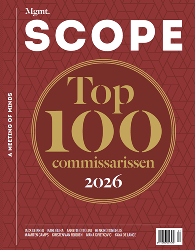Here is how to attract young digital talent

Auteur: Stef Oud | 21-03-2019
Digital transformation is inevitable, not only to keep up to date, but also to survive in the future. Every day we read about new applications of data analysis, the Internet of Things, robotization, algorithmization, artificial intelligence, et cetera. We would almost forget what identifying and developing digital solutions are really about: people. People are the defining factor, responsible for the pace of digital transformation and the success of digital solutions.
Invest in people
This was recently one of the agenda items at the annual meeting of the World Economic Forum: the central theme at 'Davos' was globalization 4.0. Almost every organization was struggling with the challenge of getting and keeping digital talent on board. One of the panel discussions, organized by A.T. Kearney, had the following subject: ‘Thrive in the digital era by investing in your most valuable asset: your people.’ When I combine the conclusions of this panel discussion with Jeroen Tas of Philips and Manuel Kohnstamm of Liberty Global, among others, who will both be sharing their experiences in this edition of Management Scope, with the experiences from our consultancy practice, I notice five aspects in which the younger generation of the working population clearly distinguishes itself from older generations.
- Master plan versus authentic vision
The first aspect concerns the need to formulate a clear and above all authentic vision and the associated digital objectives. As soon as an organization formulates a strategy, it must be able to start from a clear vision. Many organizations confuse this vision with the development of a detailed master plan. But that is something completely different: a vision includes an idea or a concept that originates from drive, flexibility, passion and entrepreneurship.
This is in contrast with having a detailed master plan and a long-term approach, which is in fact set in stone. In practice, the latter implies a series of meetings in which the original plan is used again and again. Millennials are allergic to this, they prefer a goal without a plan rather than a plan without a goal. It is smart to start with a small-scale pilot from a vision and, if successful, to scale it up and expand it quickly. Allow mistakes – because you learn from them − and constantly adjust your course. - The young initiate things (and that irritates)
A second aspect is that digital trends and concepts are increasingly initiated from the bottom up in the organization, by the beginning and younger generation. Digital natives want to have the space and confidence to do this and it is important to be aware of this. In the past, things used to be different: then it was the top and middle management who took the lead. This change creates difficulties. If the top of the organization is convinced by the younger generation, it is often middle management that is the delaying factor. This layer in the organization used to be able to create implicit power by sharing knowledge less emphatically, thereby securing its own position. The same middle management now regularly blocks digital developments and their success. They can feel threatened by a lack of knowledge and by all the changes and, where possible, put the brakes on them. It is therefore crucial to involve all layers of the organization in the digital transformation. - Preferring the collective to the individual
A third aspect is the younger generation’s desire or demand to really be able to work in teams. The digital generation likes to work in a collective, whereas many companies still rely on the individual commitment of an employee. They look far too little at the role of these individuals within teams. To attract talent, it is necessary to create a socially safe workplace where they can make mistakes within those teams. It's not about judging quickly, it's about listening! - Good salary versus social contribution
The fourth aspect is that millennials want to know from organizations how their position is in society. They do not focus so much on a good starting salary or a lease car, but on what the organization for which they may be working contributes to society. This is not about the obligatory annual fundraising campaign for the same charity each time. They want to improve society through participation − for example, by supporting others, on a pro bono basis. - Young people are entrepreneurial
A final point is that digital talent often not only wants to be involved in digital technology, but also wants to do business. This requires companies to adjust, but this also requires adjustments at the 'front end' within the various educational institutions. For example, the new Data Science University JADS in Den Bosch is actively targeting these 'datapreneurs' with its range of courses.
JADS combines the curriculum of Eindhoven University of Technology (technology, exact science) with the curriculum of Tilburg University (entrepreneurship, economics, law, marketing, ethics).
This is a good development, since many providers of traditional studies forget that the performance of professionals in the rapidly changing, dynamic ecosystems in which companies find themselves requires extremely broad knowledge.
Stef Oud is digital transformation leader and partner at A.T. Kearney.

